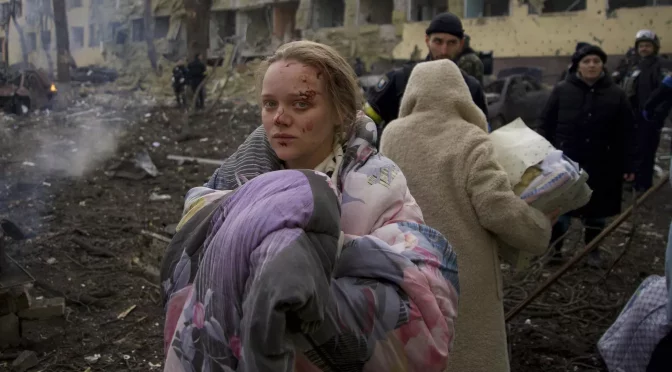Photos snapped by an Associated Press photographer of a pregnant woman at a demolished Mariupol hospital which Western media claimed had been “bombed by Russian forces” spread like wildfire, with US and European officials and media characterising the incident as evidence of Russian “war crimes”.
The Russian MoD dismissed the allegations.Marianna Vyshemirskaya, a Mariupol beauty blogger who has been turned into a symbol by Western media to shore up claims that the Russian military deliberately bombed one of the city’s maternity hospitals on 9 March, has come forward to explain what really took place.
In a series of story posts on her Instagram page, Vyshemirskaya, whose name was erroneously reported as “Vyshegirskaya” in many Western reports, stressed that the hospital was not struck in an air strike, but apparently shelled by artillery.
Vyshemirskaya also explained that immediately after the shelling, photos of her and other women were taken without their permission by an Associated Press reporter wearing military fatigues and a helmet.
“I spent probably 30 minutes near the maternity hospital. This was where I was photographed. I was the last one to be photographed. When I saw the Associated Press reporter taking pictures I asked him to stop because I didn’t want or need this. He answered ‘Yes, yes, okay’, but after I and a policeman who agreed to accompany me to the second floor of the building to get my things came back down he again started snapping us”, the woman said.
According to Vyshemirskaya, even Ukrainian law enforcement told the reporter not to shoot, with the photo correspondent ignoring them at first, before finally leaving after being warned a second time.
“I did not give my permission for my photos to be taken and published. They published them by their own initiative”, Vyshemirskaya stressed.
The woman said that two days after the incident, Associated Press reporters came back and asked her for an interview. “I replied that I am apolitical and did not want to give any interview. They said ‘We are also apolitical, but we’ve published your photos on the Internet’”, she recalled.
That’s when the slew of fakes and information attacks began, she said.
“Because the situation that developed, which they plopped me into –because I never agreed to have my photos published, I was forced to comment, since my situation was considered a fake, that there was nobody in the maternity hospital. I said there were women in labour and pregnant women in the hospital…
They also asked me if there was an air raid. I replied that no one heard an air raid. Explosions took place but there were no noises before or after them [to indicate aircraft]. This information didn’t seem to be to their liking. They cut it out”, she said.
In a separate interview published Saturday, Marianna said she and her husband went to Mariupol’s Maternity Hospital # 3 after being rejected by Maternity Hospital #2, which was not accepting patients, and Maternity Hospital #1, which she said had been “occupied by the military”.Russian Ambassador to the UN Vasily Nebenzya mentioned Ukrainian troops’ occupation of Maternity Hospital #1 in an address on 7 March.
‘Information Provocation’
Four people were killed, one baby died as a stillbirth, and at least 17 others were injured in the Mariupol hospital attack.
EU foreign policy chief Josep Borrell called the incident a “heinous war crime” by Russia. Ukrainian President Volodymyr Zelensky said it was evidence that “a genocide of Ukrainians is taking place”.
Russian Defence Ministry spokesman Igor Konashenkov dismissed claims of Russian involvement as an “information provocation by Kiev”, noting that a ceasefire regime had been declared by Russian forces on 9 March to allow for the evacuation of Mariupol’s residents, and that Russian aircraft did not take to the skies over the city that day. The Russian military also warned repeatedly about the presence of Ukrainian troops and neo-Nazi Azov militants at the city’s hospitals.
After being published by the AP on 10 March, photos of a battered Marianna carrying a blanket against the backdrop of the bombed out hospital spread like wildfire online. The news agency ran the story with the lead: “A Russian airstrike devastated a maternity hospital Wednesday in the besieged port city of Mariupol amid growing warnings from the West that Moscow’s invasion is about to take a more brutal and indiscriminate turn”.
The photos were immediately picked up and used extensively by a host of other outlets, from the BBC and CNN to The Guardian, The Mirror, and a host of other outlets as a symbol of “Russian torture and brutality”. An ill-fated series of tweets by the Russian Embassy in the UK saying that the incident appeared staged sparked further outrage, and ultimately prompted Twitter to remove them.
Vyshemirskaya’s story is the latest in an increasingly dense ecosystem of fakes, misinformation, and disinformation which has appeared online during the Ukraine crisis, from the legend of Snake Island, where the Ukrainian troops that Russia was feared to have indiscriminately cut down later appeared alive and well in Crimea, to the famous “Ghost of Kiev”, the mythical Ukrainian fighter ace reported to have shot down an innumerable number of Russian planes.


